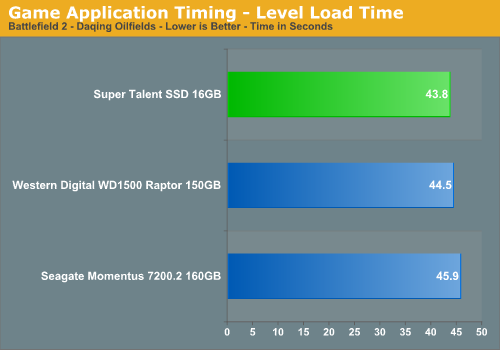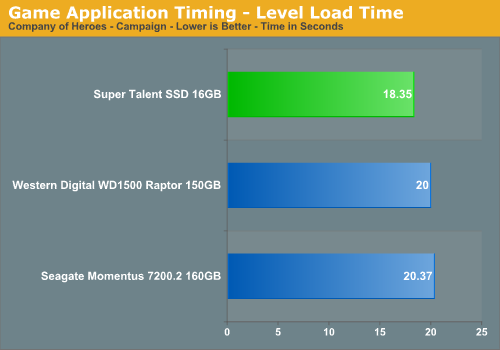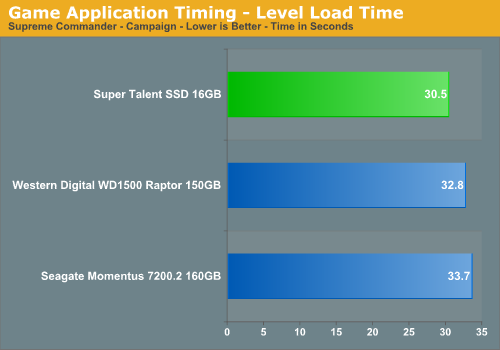Super Talent SSD: 16GB of Solid State Goodness
by Gary Key on May 7, 2007 4:00 AM EST- Posted in
- Storage
Actual Application Times - Gaming
Our application benchmarks are designed to show application performance results with times being reported in seconds, with lower scores being better. While these tests will show differences between the drives it is important to understand we are not measuring the synthetic performance of the hard drive but how well our platform performs with each individual drive. The performance of a drive is an integral part of the computer platform but other factors such as memory, CPU, core logic, and even driver choice can play a major role in determining how well the drive performs in any given task.
Game Level Load
Our tests center on the actual loading of a playable level within our game selections. It is obvious this drive is not intended to be used in gaming systems and we debated on even including these results. However, for game level loads the burst/sustained read speed and access time of a drive is very important. Considering Solid State Drives excel in low access (latency) times we thought it would be interesting to see how well this drive performed in our game tests.
The Battlefield 2 test measures the time it takes to load the Daqing Oilfields level. Our application timer begins when the start single player icon is initiated and ends when the join game icon is visible.

This is one of the more demanding game level load times we test and the Super Talent drive scores first although the margin is minimal. We fully expect the faster consumer level SSD products to improve upon these scores. After several hours of game play we could tell a slight difference between the drives in this test. The SSD product always seemed to load the levels in a smoother manner than our two hard disks, although it was difficult to determine any actual speed differences.
The Company of Heroes test measures the time it takes to load the first campaign level. Our application timer begins when the start single player icon is initiated and ends when the join game icon is visible.

Once again we see a minimal difference between our drives but the Super Talent drive is about 8% faster at loading this particular level. In repeated testing it was difficult to discern the differences between the drive setups but when compared to the Raptor the Super Talent drive is eerily quiet while playing the game. It took a little time to adjust to the acoustic differences not to mention our overall case temperatures being 3C lower after an hour of testing.
Our Supreme Commander test measures the time it takes to load the first campaign level. Our application timer begins when the start single player icon is initiated and ends when the join game icon is visible.

In our final game test the Super Talent drive is around 7% quicker at loading this particular campaign. We did not notice any issues throughout the full campaign scenario and as in the Battlefield 2 tests, the loading of the cut scenes and actual game levels was smoother although we did not perceive any differences in performance.
Our application benchmarks are designed to show application performance results with times being reported in seconds, with lower scores being better. While these tests will show differences between the drives it is important to understand we are not measuring the synthetic performance of the hard drive but how well our platform performs with each individual drive. The performance of a drive is an integral part of the computer platform but other factors such as memory, CPU, core logic, and even driver choice can play a major role in determining how well the drive performs in any given task.
Game Level Load
Our tests center on the actual loading of a playable level within our game selections. It is obvious this drive is not intended to be used in gaming systems and we debated on even including these results. However, for game level loads the burst/sustained read speed and access time of a drive is very important. Considering Solid State Drives excel in low access (latency) times we thought it would be interesting to see how well this drive performed in our game tests.
The Battlefield 2 test measures the time it takes to load the Daqing Oilfields level. Our application timer begins when the start single player icon is initiated and ends when the join game icon is visible.

This is one of the more demanding game level load times we test and the Super Talent drive scores first although the margin is minimal. We fully expect the faster consumer level SSD products to improve upon these scores. After several hours of game play we could tell a slight difference between the drives in this test. The SSD product always seemed to load the levels in a smoother manner than our two hard disks, although it was difficult to determine any actual speed differences.
The Company of Heroes test measures the time it takes to load the first campaign level. Our application timer begins when the start single player icon is initiated and ends when the join game icon is visible.

Once again we see a minimal difference between our drives but the Super Talent drive is about 8% faster at loading this particular level. In repeated testing it was difficult to discern the differences between the drive setups but when compared to the Raptor the Super Talent drive is eerily quiet while playing the game. It took a little time to adjust to the acoustic differences not to mention our overall case temperatures being 3C lower after an hour of testing.
Our Supreme Commander test measures the time it takes to load the first campaign level. Our application timer begins when the start single player icon is initiated and ends when the join game icon is visible.

In our final game test the Super Talent drive is around 7% quicker at loading this particular campaign. We did not notice any issues throughout the full campaign scenario and as in the Battlefield 2 tests, the loading of the cut scenes and actual game levels was smoother although we did not perceive any differences in performance.










44 Comments
View All Comments
Samus - Monday, May 7, 2007 - link
Simply awesome, thanks for the review Gary. This is exciting technology for sure. Only took them 20 years to make it cost effective and reasonably good storage.redbone75 - Monday, May 7, 2007 - link
I would say SSD's have a few more years to go before they become cost effective, in the home consumer market, anyway. That market will be very small until the price/GB becomes more reasonable.Lonyo - Monday, May 7, 2007 - link
Is there any chance for comparison of some 1.8" drives in the future?Since 1.8" mechanical drives are somewhat slower than 2.5 or 3.5" mechanical drives, and 1.8" laptops are looking at things like low power consumption, it would be nice to see, assuming you can get hold of some 1.8" drives of both types.
Reflex - Monday, May 7, 2007 - link
These drives are great in an embedded or manufacturing environment. Typically they are not written to frequently so you will never hit the write limitations. As a desktop PC drive however that write limitation could be hit very quickly, within a year even. Furthermore, having worked with these drives extensively in embedded environments, I will point out that when the write limitation is hit, you can no longer read the device either. Since there is no real warning, you simply suddenly lose access to all data on that drive.Solid state storage is the future, but not in the form of today's flash. The write limitation is severe, and very problematic. There are competing technologies that hopefully will show up sooner rather than later.
falc0ne - Monday, May 7, 2007 - link
"The SSD16GB25/25M features a read seek time of less than 1ms, a maximum read/write speed of up to 28 MB/sec, a sustained transfer rate of 25 MB/sec, and an estimated write/erase cycle of approximately 100,000 cycles. This equates into a 1,000,000 hour MTBF rating and indicates a 10 year life expectancy based upon normal usage patterns. Super Talent has developed a set of proprietary wear leveling algorithms along with built in EDD/EDC functions to ensure excellent data integrity over the course of the drive's lifespan."This passage tells a completely different story..
mongo lloyd - Monday, May 7, 2007 - link
Dan at Dansdata.com has said the exact same things as Reflex here for quite a while, and I tend to believe him more than SuperTalent's PR department.Also, as Reflex points out, NAND flash has usually way more than 100,000 write/erase cycles. 1 million cycle is not too uncommon.
Regular CompactFlash memory (previously NOR flash, nowadays NAND flash) can take up to the same order of magnitude of write/erase cycles, and we all know memory cards for digital cameras have quite a finite life. And that's without putting a paging file on them.
PandaBear - Thursday, May 10, 2007 - link
It depends on what kind of Nand. MLC usually can barely hit 100k for good ones (i.e. Toshiba and SanDisk) while 5k for bad ones (i.e. some batch of Samsung that got rejected and they have to dump in the spot market).For a camera, you will have to wear out your camera's shutter before you can wear out the card, but for HD, you better have very good wear leveling and good nand before even attempting).
Gary Key - Monday, May 7, 2007 - link
The manufacturer's are taking a conservative path with the write/erase cycles per sector and it has been difficult to nail them down on it. The latest information I have from SanDisk as an example is that the non-recoverable error rate is 1 error per 10 to the 20th bits read on their current drives but they have not committed to active duty cycles or power-on hours in arriving at that calculation. The majority of the SSD suppliers are focused on MTBF ratings at this time. We will have further details in our consumer article as I expect Samsung to open up on the subject.PandaBear - Thursday, May 10, 2007 - link
Nand don't wear out by sitting around, they wear out by erase/program permanently or read disturb (recoverable just by a rewrite). So MTBF is meaningless. You have to do a lot of reading continuously in order to wear out by read. Actually there are algorithms that protect such cases already by refreshing it, so no harm is done.It is the write that really kills the sector, and Samsung did not mention its erase/program for a reason: they failed their own spec that many reputable clients rejected their order (i.e Sandisk rejected their order from Samsung MLC, and Apple uses excessive recovery algorithm to tolerate them on the audio playback, those Taiwanese cheap flash that you get for free with super slow performance or die after 2 weeks, well, you know what you will get when you open up the case).
For their SSD, they may use SLC instead for the performance and reliability reason. It costs 20% more in spot market, but manufacturing cost is much higher (almost 2x when you think about it), so it will cost more.
Reflex - Monday, May 7, 2007 - link
First off, 100,000 is a VERY VERY low write rating for flash, typical drives nowadays have 250k+ write cycles.Secondly, as pointed out by the article, the intended market is industrial and embedded, which as I stated originally, is an environment where the drives are rarely written to. Typically you have a bootable image in those environments, and it is write protected in some fashion, or requires a very small number of writes.
And finally, if you think 100k write cycles is a lot, watch the drive light on the front of your PC someday. Every flash is a minimum of one write or read operation. Calculate how many times that flashes in ten minutes of 'typical' use. Then extrapolate. You'll understand what I mean.